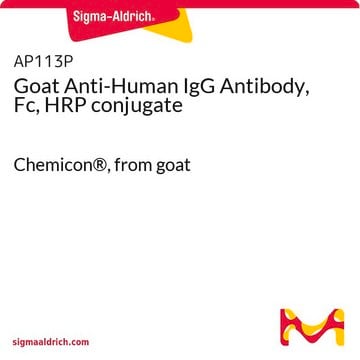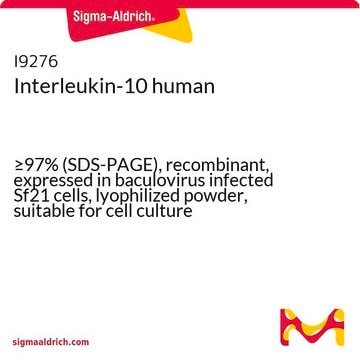おすすめの製品
由来生物
mouse
品質水準
抗体製品の状態
purified immunoglobulin
抗体製品タイプ
primary antibodies
クローン
4B6, monoclonal
化学種の反応性
sheep
メーカー/製品名
Chemicon®
テクニック
ELISA: suitable
アイソタイプ
IgG1
NCBIアクセッション番号
UniProtアクセッション番号
輸送温度
dry ice
ターゲットの翻訳後修飾
unmodified
遺伝子情報
sheep ... Il6(443406)
特異性
Reacts with ovine IL-6. No reactivity detected to recombinant ovine IL-1beta, IL-8, MCP or TNFalpha.
SPECIES REACTIVITY:
The antibody is likely to react with caprine (goat) IL-6.
SPECIES REACTIVITY:
The antibody is likely to react with caprine (goat) IL-6.
免疫原
Recombinant ovine IL-6
アプリケーション
Research Category
炎症及び免疫
炎症及び免疫
Research Sub Category
サイトカイン及びサイトカイン受容体
サイトカイン及びサイトカイン受容体
Capture antibody in ELISA. Recommended coating concentration 5 μg/mL. See suggested protocol.
Optimal working dilutions must be determined by the end user.
Suggested ELISA Protocol For Ovine IL-6
1. Coat high capacity microtitre wells (e.g. Nunc maxisorp) with monoclonal anti-IL-6 antibody (Chemicon Catalog Number MAB1004) at a concentration of 5 μg/mL in 0.1 M carbonate buffer pH 9.6 overnight at 4ºC.
2. Wash wells 3 x with PBS + 0.05% Tween 20 (PBST).
3. Add samples to wells. Incubate at room temperature in a humidified box for 1 hour. Wash 3 x with PBST.
4. Dilute rabbit anti-IL-6 (Chemicon Catalog Number AB1839) 1:500 in PBST and add 100 μL to wells. Incubate at room temperature for 30 minutes. Wash 3 x with PBST.
5. Dilute anti-rabbit IgG-HRP to appropriate level in PBST and add 100 μL to wells. Incubate 30 minutes at room temperature. Wash 3 x with PBST.
6. Add 100 μL of TMB chromagen to each well. Incubate for 5-10 minutes and stop reaction with 50 μL of 2M sulfuric acid.
Notes:
The anti-rabbit IgG HRP must be adsorbed against mouse immunoglobulin, and should be checked for non-reactivity with coated plates.
Non-specific binding may be reduced by addition of protein such as skim milk powder to the diluents.
Assay sensitivity may be altered by adjusting incubation times and reagent concentrations.
Optimal working dilutions must be determined by the end user.
Suggested ELISA Protocol For Ovine IL-6
1. Coat high capacity microtitre wells (e.g. Nunc maxisorp) with monoclonal anti-IL-6 antibody (Chemicon Catalog Number MAB1004) at a concentration of 5 μg/mL in 0.1 M carbonate buffer pH 9.6 overnight at 4ºC.
2. Wash wells 3 x with PBS + 0.05% Tween 20 (PBST).
3. Add samples to wells. Incubate at room temperature in a humidified box for 1 hour. Wash 3 x with PBST.
4. Dilute rabbit anti-IL-6 (Chemicon Catalog Number AB1839) 1:500 in PBST and add 100 μL to wells. Incubate at room temperature for 30 minutes. Wash 3 x with PBST.
5. Dilute anti-rabbit IgG-HRP to appropriate level in PBST and add 100 μL to wells. Incubate 30 minutes at room temperature. Wash 3 x with PBST.
6. Add 100 μL of TMB chromagen to each well. Incubate for 5-10 minutes and stop reaction with 50 μL of 2M sulfuric acid.
Notes:
The anti-rabbit IgG HRP must be adsorbed against mouse immunoglobulin, and should be checked for non-reactivity with coated plates.
Non-specific binding may be reduced by addition of protein such as skim milk powder to the diluents.
Assay sensitivity may be altered by adjusting incubation times and reagent concentrations.
This Anti-Interleukin-6 Antibody, clone 4B6 is validated for use in ELISA for the detection of Interleukin-6.
物理的形状
Format: Purified
Liquid in PBS containing 0.1% sodium azide.
保管および安定性
Maintain at -20°C in undiluted aliquots for up to 12 months. Avoid repeated freeze/thaw cycles.
その他情報
Concentration: Please refer to the Certificate of Analysis for the lot-specific concentration.
法的情報
CHEMICON is a registered trademark of Merck KGaA, Darmstadt, Germany
免責事項
Unless otherwise stated in our catalog or other company documentation accompanying the product(s), our products are intended for research use only and are not to be used for any other purpose, which includes but is not limited to, unauthorized commercial uses, in vitro diagnostic uses, ex vivo or in vivo therapeutic uses or any type of consumption or application to humans or animals.
Not finding the right product?
Try our 製品選択ツール.
保管分類コード
10 - Combustible liquids
WGK
WGK 2
引火点(°F)
Not applicable
引火点(℃)
Not applicable
適用法令
試験研究用途を考慮した関連法令を主に挙げております。化学物質以外については、一部の情報のみ提供しています。 製品を安全かつ合法的に使用することは、使用者の義務です。最新情報により修正される場合があります。WEBの反映には時間を要することがあるため、適宜SDSをご参照ください。
Jan Code
MAB1004:
試験成績書(COA)
製品のロット番号・バッチ番号を入力して、試験成績書(COA) を検索できます。ロット番号・バッチ番号は、製品ラベルに「Lot」または「Batch」に続いて記載されています。
Gunlawadee Maneenil et al.
PloS one, 10(3), e0119281-e0119281 (2015-03-21)
A fetal inflammatory response (FIR) in sheep can be induced by intraamniotic or selective exposure of the fetal lung or gut to lipopolysaccharide (LPS). The oral, nasal, and pharyngeal cavities (ONP) contain lymphoid tissue and epithelium that are in contact
Ruth Gussenhoven et al.
Developmental neuroscience, 39(6), 472-486 (2017-08-30)
Chorioamnionitis is associated with adverse neurodevelopmental outcomes in preterm infants. Ureaplasma spp. are the microorganisms most frequently isolated from the amniotic fluid of women diagnosed with chorioamnionitis. However, controversy remains concerning the role of Ureaplasma spp. in the pathogenesis of
Charlotte van Gorp et al.
Nutrients, 11(5) (2019-05-01)
Chorioamnionitis, clinically most frequently associated with Ureaplasma, is linked to intestinal inflammation and subsequent gut injury. No treatment is available to prevent chorioamnionitis-driven adverse intestinal outcomes. Evidence is increasing that plant sterols possess immune-modulatory properties. Therefore, we investigated the potential
Modulation of lipopolysaccharide-induced chorioamnionitis by Ureaplasma parvum in sheep.
Snyder, CC; Wolfe, KB; Gisslen, T; Knox, CL; Kemp, MW; Kramer, BW; Newnham, JP; Jobe et al.
American Journal of Obstetrics and Gynecology null
Tate Gisslen et al.
Innate immunity, 20(2), 214-224 (2013-06-12)
Histologic chorioamnionitis, frequently associated with preterm births and adverse outcomes, results in prolonged exposure of preterm fetuses to infectious agents and pro-inflammatory mediators, such as LPS. Endotoxin tolerance-type effects were demonstrated in fetal sheep following repetitive systemic or intra-amniotic (i.a.)
ライフサイエンス、有機合成、材料科学、クロマトグラフィー、分析など、あらゆる分野の研究に経験のあるメンバーがおります。.
製品に関するお問い合わせはこちら(テクニカルサービス)







